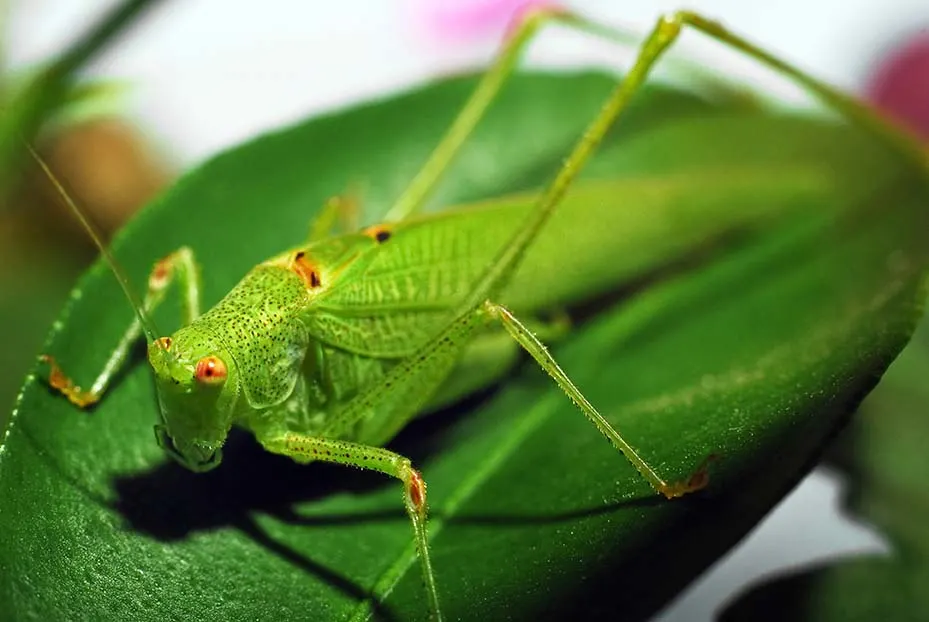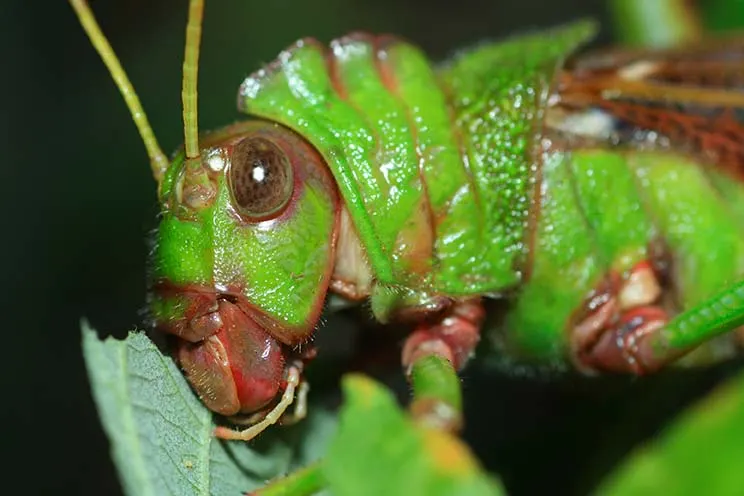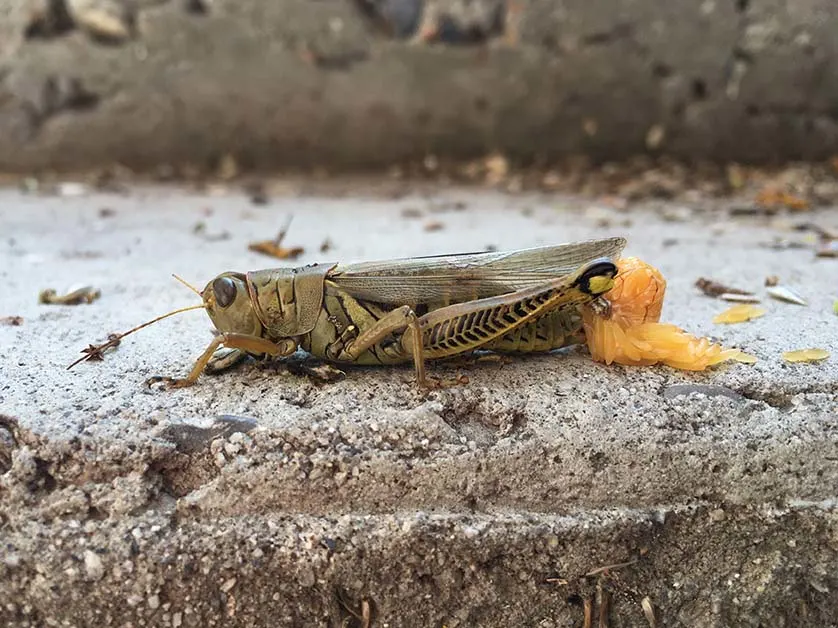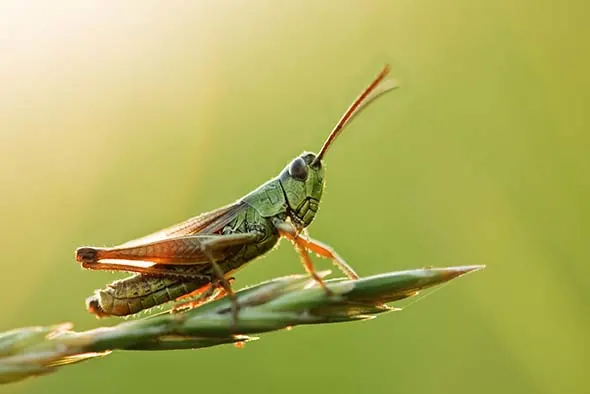Who's ready to learn some interesting facts about grasshoppers? You'll find lots of cool information in this blog post!

Grasshoppers are found on every continent in the world except for Antarctica. There are two main groups of grasshoppers divided according to the length of their antennae (feelers) which are also called horns. The two groups are: long-horned grasshoppers and short-horned grasshoppers. Short-horned grasshoppers are usually called locusts.
Physical Description of Grasshoppers
Grasshoppers are medium to large insects. Adult length is 0.4 to 2.75 inches (1 to 7 cm), depending on the species. Female grasshoppers are typically larger than males.
Grasshoppers have the typical insect body of head, thorax and abdomen.
Grasshoppers have five pairs of eyes. Two are compound eyes (an eye which contains multiple eye-like structures) and 3 pairs of simple eyes. They have a pair of thread-like antennae that are sensitive to touch and smell. Their mouth parts are modified for chewing.

Grasshoppers are colored to blend into their environment, usually a combination of brown, grey or green. In some species, the males have brightly colored wings used to attract females. There are also some species that are brightly colored to warn predators that they eat toxic plants and the toxins stay in their body for protection.
They have two pairs of wings, one narrow and tough, the other wide and flexible. Most grasshoppers use their long hind legs for jumping as a booster to propel them into the air. Once in the air they spread their wings and fly.
Female grasshoppers have sharp points at the end of their abdomen that help them lay eggs underground. Some male grasshoppers have special structures on their wings that they rub their hind legs on, or rub together, to make sounds that attract females.
Habitat
One of the interesting facts about grasshoppers is that they generally prefer dry open habitats with lots of grass and low plants, anywhere they can find large amounts of food to eat. There are some species that live in forests or jungles. Many grassland species invade farm fields.
Grasshoppers migrate to find new sources of food so they don’t have nests, territories or a general home base.
Habits
Grasshoppers are most active during the day, but may also feed at night. Most species are solitary, only coming together with other grasshoppers to mate. However, sometimes migratory species gather in huge groups of millions or even billions.
Grasshoppers primarily use sound and sight to communicate. Scent and touch are important during mating.
Grasshoppers' Diet
Grasshoppers are herbivores that eat a lot. An average grasshopper can eat 16 time its own weight. Their favorite foods are plants in the grass family such as corn, wheat, barley and alfalfa. However, they are not picky and can eat many other types of plants.

Offspring
Grasshoppers mate in late summer or fall. After mating, the female will lay hundreds of eggs in the ground. The eggs remain in the ground through winter, and they usually hatch in late May.
A newly hatched grasshopper is called a nymph. Nymphs go through multiple metamorphosis stages. They shed between each stage and can shed 5 to 6 times. Each stage looks a lot like the adult, but with a few changes each time. After the last shed, they are adults and can reproduce. Most species also get wings when they are adults.

Classification/Taxonomy
Kingdom: Animalia
Phylum: Arthropoda
Class: Insecta
Order: Orthoptera
Suborder: Caelifera
Infraorder: Acrididae
There are over 11,000 known species of grasshoppers.
History
Grasshoppers predate dinosaurs. The earliest fossils of grasshoppers date back to 300 million years ago during the Carboniferous period.
Predators
Grasshoppers have many predators. The grasshopper’s primary predators are flies. Many types of flies will lay their eggs in or near grasshopper eggs. When the fly eggs hatch, the newborn flies eat the grasshopper eggs. Some flies lay their eggs directly onto the grasshopper’s body. The newborn flies eat the grasshopper. Who would have know these interesting facts about grasshoppers?
Other grasshopper predators include bee-flies, ground beetles and blister beetles which eat grasshopper eggs; ants, robber flies, praying mantises, wasps, spiders, lizards and many birds and small mammals which eat nymphs and adult grasshoppers.
Grasshoppers have a few defense mechanisms to protect themselves from predators. Their preferred defense is to jump away to avoid capture, hiding among grass or leaves. But with their strong jaws they may bite a predator.

When picked up, a grasshopper may spit a brown liquid which is known as “tobacco juice.” Some scientists believe the liquid may protect grasshoppers from attacks by insects such as ants and other predators. They spit the liquid and then use their strong legs to boost up and fly away.
Lifespan
The lifespan of a grasshopper is determined by the climate it resides in. In colder climates, grasshoppers can only survive the winter as an egg. Adult grasshoppers do not survive low temperatures. In warm climates, grasshoppers can live for several years.
25 Unusual Facts about Grasshoppers
- A small cuticle in a grasshopper’s knee acts as a spring that lets it catapult its body into the air.
- Adult grasshoppers are capable of leaping 10 times their length straight into the air and 20 times their length horizontally without using its wings. That means if a grasshopper is 2 inches long (5 cm) long, it can jump a distance of 40 inches (1 meter).
- The peak acceleration during a grasshopper’s take-off approaches 20 G. For comparison, when flying a fighter jet, you can experience G forces up to 9 G.
- Grasshoppers can reach a speed of 8 miles (13 km) per hour when flying.
- Locusts typically live alone, but are famous for forming giant swarms that can swoop down and destroy massive areas of crops.
- The largest recorded locust swarm was the now-extinct Rocky Mountain locust in 1875. The swarm was 1,800 miles (2,900 km) long and 110 miles (180 km) wide. One estimate puts the number of locusts involved as 3.5 trillion.
- Grasshoppers are commonly eaten in African, Asian, Central and South American countries. They are a very good source of protein.
- The Ohlone people burned grassland to herd grasshoppers into pits where they could be collected and used as food.
- In the Bible, John the Baptist ate locusts and wild honey while living in the wilderness.
- The Egyptian word for locust or grasshopper was written snḥm in the consonantal hieroglyphic writing system.
- In Greek mythology, grasshoppers symbolize immortality.
- When grasshoppers appear in dreams, they have been interpreted as symbols of freedom, independence, spiritual enlightenment, or the inability to settle down or commit to decision.
- In Japan, grasshoppers are a sign of good luck.
- Grasshoppers have ears on their abdomen. They act as special receptors that can catch changes in pressure but they cannot differentiate different pitches.
- When grasshoppers rub their hind legs to produce sound, it is called stridulation. These sounds are mostly made by males to attract females. Few females produce these sounds.
- Grasshoppers have other sense organs called chordotonal sense organs. They can detect the position and movement about the joints of the exoskeleton.
- Grasshopper respiration occurs through the trachea. Circulation is through an open circulatory system. In the open circulatory system, organs are bathed in blood receiving their oxygen and nutrients directly.
- In the US, grasshoppers cause damage of around $1.5 billion to crops each year.
- Grasshoppers migrate during the winter to find food and warmer climates.
- Grasshoppers can stay in flight for three days straight.
- In the movie A Bug’s Life, the main villain and his henchmen were all grasshoppers.
- The hooded leaf grasshopper mimics the look and colors of certain leaves.
- Stick grasshoppers mimic the look and color of wooden sticks.
- Sometimes grasshoppers scavenge dead insects for extra protein.
- No grasshoppers are known to be endangered.
Check out these other cool insects!
